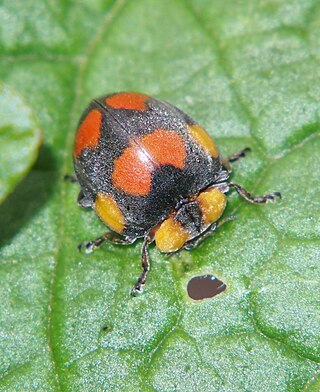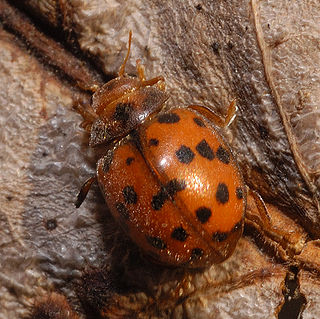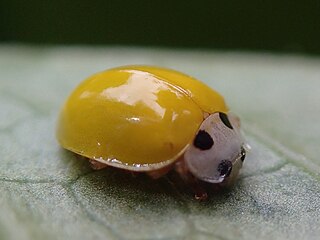
Apiaceae or Umbelliferae is a family of mostly aromatic flowering plants named after the type genus Apium and commonly known as the celery, carrot or parsley family, or simply as umbellifers. It is the 16th-largest family of flowering plants, with more than 3,800 species in about 446 genera, including such well-known and economically important plants as ajwain, angelica, anise, asafoetida, caraway, carrot, celery, chervil, coriander, cumin, dill, fennel, lovage, cow parsley, parsley, parsnip and sea holly, as well as silphium, a plant whose exact identity is unclear and which may be extinct.

Harmonia axyridis is a large lady beetle or ladybug species that is most commonly known as the harlequin, Asian, or multicoloured Asian lady beetle. This is one of the most variable species in the world, with an exceptionally wide range of colour forms. It is native to eastern Asia, but has been artificially introduced to North America and Europe to control aphids and scale insects. It is now common, well known, and spreading in those regions, and has also established in Africa and widely across South America. This species is conspicuous in North America, where it may locally be known as the Halloween beetle, as it often invades homes during October to overwinter.

Ladybird Books is a London-based publishing company, trading as a stand-alone imprint within the Penguin Group of companies. The Ladybird imprint publishes mass-market children's books.

Velvet spiders are a small group of spiders almost entirely limited to the Old World, with the exception of one species known from Brazil. In Europe, some are commonly called the ladybird spiders.

Adalia bipunctata, the two-spot ladybird, two-spotted ladybug or two-spotted lady beetle, is a carnivorous beetle of the family Coccinellidae that is found throughout the holarctic region. It is very common in western and central Europe. It is also native to North America but it has heavily declined in many states and provinces. It is commonly introduced and imported as a biological control agent.

Coccinella septempunctata, the seven-spot ladybird, is a carnivorous beetle native to the Old World and is the most common ladybird in Europe. The beetle is also found in North America, Central and Eastern Asia and regions with a temperate climate. Its elytra are of a red colour, but each punctuated with three black spots, with one further spot being spread over the junction of the two, making a total of seven spots, from which the species derives both its common and scientific names.

Psyllobora vigintiduopunctata, the 22-spot ladybird, is a common, 3–5 mm long ladybird native to Europe. The elytra are yellow in colour with 22 black spots. The pronotum is yellow or white with 5 black spots. Unlike most other ladybirds which feed on aphids, P. 22-punctata eats mildew — especially from umbellifers and low-growing shrubs . The 22-spot ladybird is best looked for amongst low vegetation.

Coccinellidae is a widespread family of small beetles. They are commonly known as ladybugs in North America and ladybirds in the United Kingdom; "lady" refers to mother Mary. Entomologists use the names ladybird beetles or lady beetles to avoid confusion with true bugs. The more than 6,000 described species have a global distribution and are found in a variety of habitats. They are oval beetles with a domed back and flat underside. Many of the species have conspicuous aposematic (warning) colours and patterns, such as red with black spots, that warn potential predators that they taste bad.

Hesperomyces is a genus of fungi in the family Laboulbeniaceae. The genus contains ten species, including the type species, the Green Beetle Hanger. H. virescens is a complex of species. It is an ectoparasite of an invasive species to Europe and the Americas, the harlequin ladybird. Laboratory bioassays pointed out that Hesperomyces-infected ladybirds suffered increased mortality rates.

Hippodamia variegata, the Adonis ladybird, also known as the variegated ladybug (US) and spotted amber ladybeetle (Aus), is a species of ladybeetle belonging to the family Coccinellidae, subfamily Coccinellinae.

Dinocampus coccinellae is a braconid wasp parasite of coccinellid beetles, including the spotted lady beetle, Coleomegilla maculata. D. coccinellae has been described as turning its ladybird host into a temporary "zombie" guarding the wasp cocoon. About 25% of Coleomegilla maculata recover after the cocoon they are guarding matures, although the proportion of other ladybird species which recover is much lower.

Papuaepilachna guttatopustulata, the large leaf-eating ladybird, is a species of ladybird, formerly in the genus Henosepilachna endemic to parts of Australasia, specifically New South Wales, Queensland, the Bismarck Archipelago, New Guinea, New Hebrides and Solomon Islands.

Cheilomenes is a genus of ladybirds (Coccinellidae). Like other members of their subfamily they are large typical ladybirds. They are always shiny and often have bright spots on the elytra. The common African species C. lunata is an important predator of the citrus aphid, Toxoptera, and wheat aphid, while C. vicina has been suggested as a biological control agent for the cowpea aphid. Both the larvae and adults are predatory. Freshly emerged larvae consume unhatched eggs, and eventually have a dappled appearance and 6 tubercles on each abdominal segment. Vulnerable stages in the life of C. sexmaculata, including oviposition, hatching, moulting and pupation have been shown to occur after dark, probably as an adaptation to avoid exposure to natural enemies.

Exochomus quadripustulatus, common name pine ladybird or pine lady beetle, is a species of beetle of the family Coccinellidae. The distribution range of E. quadripustulatus includes Europe, Northern Asia, and North America.

Subcoccinella vigintiquatuorpunctata is a beetle in the family Coccinellidae. It is the only member of the genus Subcoccinella. It has the typical, almost semi-spherical, ladybird shape and is patterned with spots. However it differs from many of the well-known ladybirds in being neither smooth and shiny nor an eater of aphids: the wing-cases look velvety and it eats fungal moulds on plants.

Ladybirds were an American pop rock band from West Chester, Pennsylvania.

Aphidecta obliterata is a species of Coccinellidae, a flying beetle.

Myzia oblongoguttata, commonly known as the striped ladybird, is a species of beetle in family Coccinellidae. It is found in the Palearctic.

Helen Elizabeth Roy, is a British ecologist, entomologist, and academic, specialising in ladybirds and non-native species. Since 2007, she has been a principal scientist and ecologist at the NERC's Centre for Ecology & Hydrology. From 1997 to 2008, she taught at Anglia Ruskin University, rising to the rank of Reader in Ecology. She is the co-organiser of the UK Ladybird Survey, alongside Dr Peter Brown, is a visiting professor in the School of Biological Sciences, University of Reading, is co-chair of the IPBES assessment of invasive alien species, and is a past President of the Royal Entomological Society.

Illeis is a genus of ladybird beetles in the family Coccinellidae. There are about five described species in Illeis, found in south and east Asia and in Oceania.




















